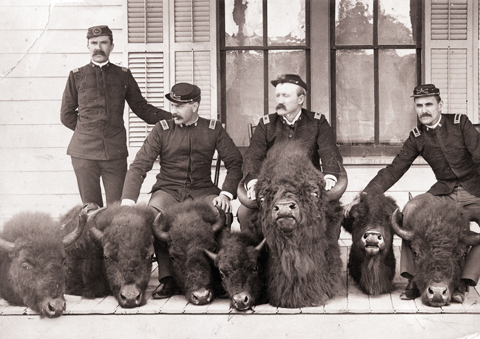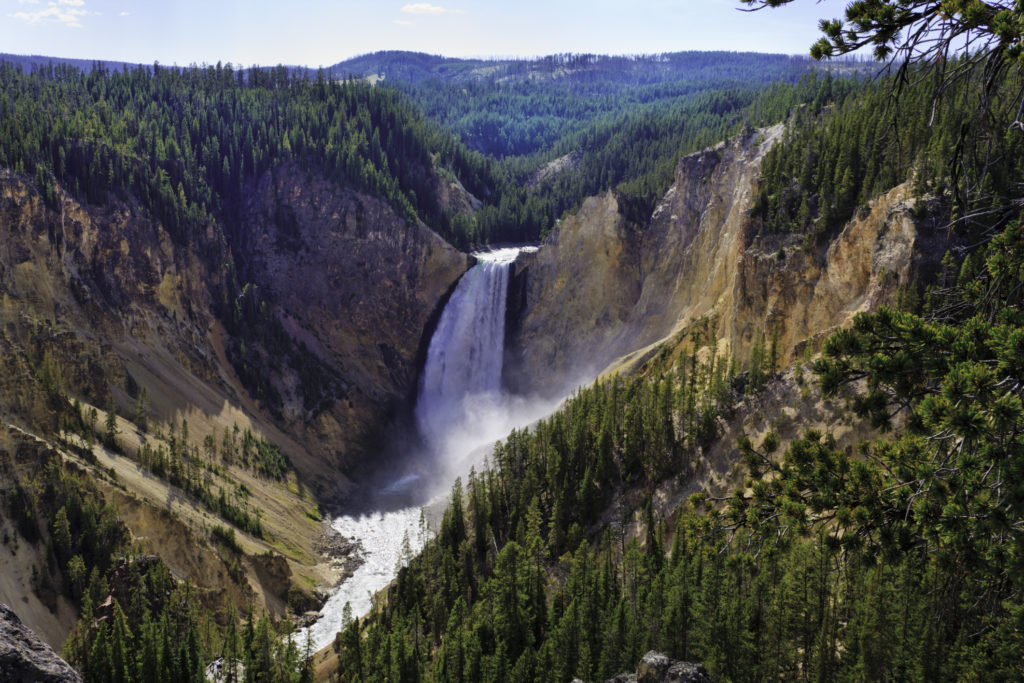The past 2 weeks I read The Yellowstone Story (Vols 1, 2). I also read the daily news: conservation and environmental stories in particular. When I line up the Yellowstone Story next to the current public lands crisis (e.g., rescinding National Monument status of public lands), I find a remarkable parallel in the story lines. The dark side of Yellowstone (YNP) history provides all the encouragement that we need to preserve and protect national land, today
When Americans entered the Yellowstone area in the mid-1800s, stories spread quickly of abundant wildlife, roaring rivers, gorgeous mountains, and odd thermal features. Hunters, trappers, miners, and adventure seekers invaded. They trapped out the forests and slaughtered large mammals mostly for the fur and their tongues. The rest of the carcasses rotted on the meadows and in streambeds. Campfires left unattended set off large wildfires, and miners littered the countryside with toxic mining wastes. Treasure seekers climbed over and broke off pieces of the thermal features as souvenirs.

Wolf hides
Survey parties and small groups of military men who were chasing Indians reported the chaos in the Wonderland, and a concerned Congress saw this as the final impetus to create YNP. Unfortunately, the first Park Supervisors and staff were inept, and even more poachers and treasure seekers paid them off and entered the park. Rough guys created all kinds of havoc in the lawless park while the others continued to plunder the resources. Businessmen fought deadly battles to win the monopoly on services, such as hotels and restaurants.
How bad was the animal slaughter in the new park? Philetus Norris, an early Park Superintendent, estimated that in 1875: “2000 hides of elk, nearly as many each of the bighorn, deer, and antelopes and hundreds of moose and bison were taken out of the park.”
Area residents, other concerned citizens, upper-class visitors – the only kind – and disgruntled business people sent detailed reports to Washington. Even the famous John Muir, who visited YNP, spoke out harshly about the human chaos and degradation of the Yellowstone ecosystem.
A series of new Park Superintendents could not bring order and some national leaders wanted to rescind the order creating the park, saying it was a waste of money. Instead, Congress sent in the troops, in 1886. They built a small fort and patrolled the popular spots to keep people from vandalizing the features. They rooted out poachers and burned their cabins. They sent scallywags packing. For a time, peace and order descended on the beautiful landscape.

Soldiers kept busy raiding the poacher’s stashes of bison trophy heads and other animal parts

The Fort expanded over the years, and the buildings still stand, in Mammoth Springs, North Entrance
With poachers gone, Park officials successfully managed the large mammals for a time but were complicit in killing the wolves and many coyotes. They also trapped and hunted hundreds of cougars. Animal management in those days meant killing off the predators. Of course, the large mammals then fell to disease and hunger without the natural predator cycles. Herds dwindled, even without predators.
Then, the railroad barons, who wanted to control transportation and all other services inside Yellowstone, employed their subversive and violent tactics (see the novel The Octopus for a great read about the evils of the railroad in California farming towns.) It was a complex, ugly, and deadly war for railroad access and concession rights, and the railroad wars did not end until people started driving autos into Yellowstone.

All Americans concerned with climate change, conservation, and biodiversity should read the Yellowstone Story (or a shorter version). The sad history reminds us about human nature as we face new degradation (via mining, oil extraction, etc) of our public lands. Greed rules. Given access, people will extract and destroy whatever they encounter in the natural world. Furthermore, greed leads to corruption and violence of every type. A sad modern tale: the recent shooting of a well-known white wolf who lived near Gardiner.
After reading about YNP history, Americans should also take a tour of the west–a special journey that takes them beyond the National Parks. On this trip: no Glacier, Yellowstone, or Canyonlands. The journey will begin in Butte, MT. From there, Anaconda, MT, and all the other Superfund sites out west. Radioactive mine tailings outside Moab, polluted rivers like the Spokane, where you cannot eat the fish you catch. The tour will also include the Summitville Mine in Southern Colorado, where surface water, groundwater and soil contaminated with copper, cadmium, manganese, zinc, lead, nickel, aluminum, and iron, leaches into the Alamosa River system from an isolated former mine at 12,500 ft.
Of course, we don’t need to come west, the east has as many if not more Superfund sites. How about the more famous Love Canal in New York and the lesser known Alaric Area Groundwater Plume in the Upper Floridian Aquifer that contains contamination by ugly carcinogens (PCE, TCE). All of American history is overflowing with the destruction of our ecosystems in the pursuit of progress. Forests are gone, animals extinct, water polluted. And now, a renewed push to exploit and extract our protected lands. Twenty-first-century fossil fuel folks care little about the messes left behind, because greed rules, still. What’s worse, we don’t need to destroy our lands anymore. The extraction industries (e.g., coal) are becoming less profitable and clean energy is advancing around the world. New technologies are offering us new solutions, and that should encourage us to conserve every square inch of public land that we can. Large landowners should be encouraged to create more conservation easements. Ted Turner is a great role model in this and many more can follow his leadership.
Well, I set out to draw a link between the land abuses in what is now YNP and the current push to free up public lands for industries. My goal: to convey a sense that people never change; thus, we need our government to protect and conserve our lands, our ecosystems, and our water. Not long ago we took the global lead in these matters. Now we are global buffoons. I have another goal for the near future, to share why preserving our lands is so important. I have wrestled with different ways to write about it and will work it out at some point! More is at stake than breathtaking views. Send in the troops and get the greedy off our lands.

Yellowstone Falls – Grand Canyon of the Yellowstone – Yellowstone National Park, Montana (MT).



What an epic post, Jane! I am horrified to read about the devastation caused by early arrivals to the park. Man’s total selfishness and lack of decency! Yet, I’m sure this happened in many regions in which the abundance was so great that people thought we would never run out of resources. Your last picture of the waterfall is wonderful. It is good to know such beauty remains.
Lack of decency….well put!!